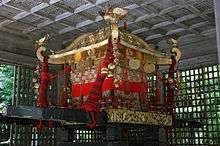Mikoshi


A mikoshi (Japanese: 神輿) is a divine palanquin (also translated as portable Shinto shrine). Shinto followers believe that it serves as the vehicle to transport a deity in Japan while moving between main shrine and temporary shrine during a festival or when moving to a new shrine. Often, the mikoshi resembles a miniature building, with pillars, walls, a roof, a veranda and a railing.
Often the Japanese honorific prefix o- (お) is added, making omikoshi (お神輿).
Shapes
Typical shapes are rectangles, hexagons, and octagons. The body, which stands on two or four poles (for carrying), is usually lavishly decorated, and the roof might hold a carving of a phoenix.
Festival and flow
During a matsuri (Japanese festival) involving a mikoshi, people bear the mikoshi on their shoulders by means of two, four (or sometimes, rarely, six) poles. They bring the mikoshi from the shrine, carry it around the neighborhoods that worship at the shrine, and in many cases leave it in a designated area, resting on blocks called uma (horse), for a time before oly from side to side to "amuse" the deity (kami) inside.
Kind of shouldering types
The most common method of shouldering in Japan is hira-katsugi (平担ぎ) "flat carry". Bearers chant wasshoi (わっしょい) and may or may not toss and shake the mikoshi.
Other methods include:
- Edomae (江戸前) "Edo style" is one famous way of shouldering observable at the Asakusa Sanja Festival. The shout is "say ya, soi ya, sah, sorya... etc". The mikoshi is swayed rapidly, up and down and a little to the right and left.
- "Dokkoi | ドッコイ " is seen in Shonan in Kanagawa Prefecture. This shouldering style usually uses two poles. The mikoshi is moved up and down rhythmically, and more slowly than in the "Edomae style". One shout is "dokkoi dokkoi dokkoi sorya" and there is a song called a "Jink | lively song."
- Another one is "Odawara style | 小田原担ぎ " observed in Odawara (next to the Hakone). This is a peculiar way of shouldering in which multiple mikoshis meet and run (Holy Dash). The shout is "oisah;korasah/koryasah." and there is a song called a "Kiyari | "log-carriers(fishermans) chant". The bearers do not sway the mikoshi.
- In this "united" style, the mikoshi uses the full width of the road, moving from side to side and turning corners at full speed.
See also
References
- Sokyo Ono, William P. Woodward, Shinto - The Kami Way, Charles E. Tuttle Company, Tokyo 1992, ISBN 4-8053-0189-9
- Basic Terms of Shinto, Kokugakuin University, Institute for Japanese Culture and Classics, Tokyo 1985
External links
- Mikoshi Photos of Shinto shrine (English version)
- Mikoshi Festival
- Shin'yo, in the Encyclopedia of Shinto by the Kokugakuin University
| Wikimedia Commons has media related to Mikoshi. |